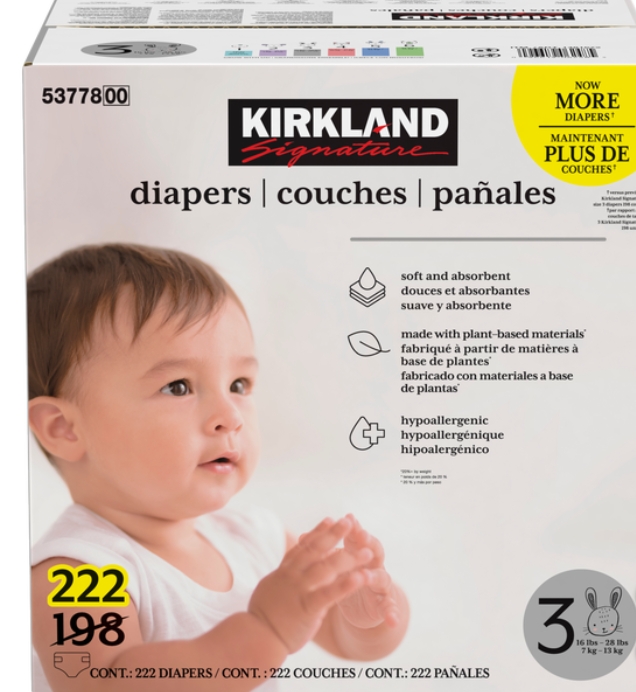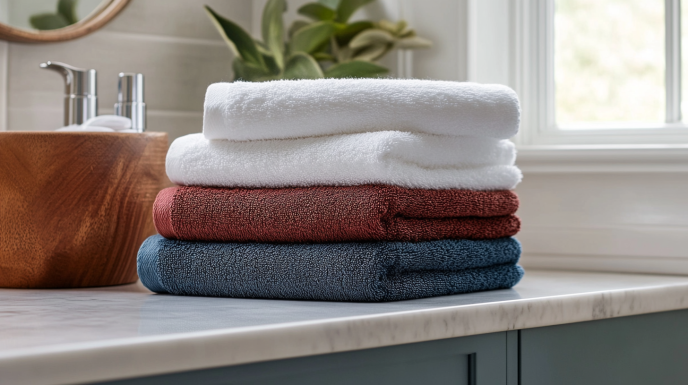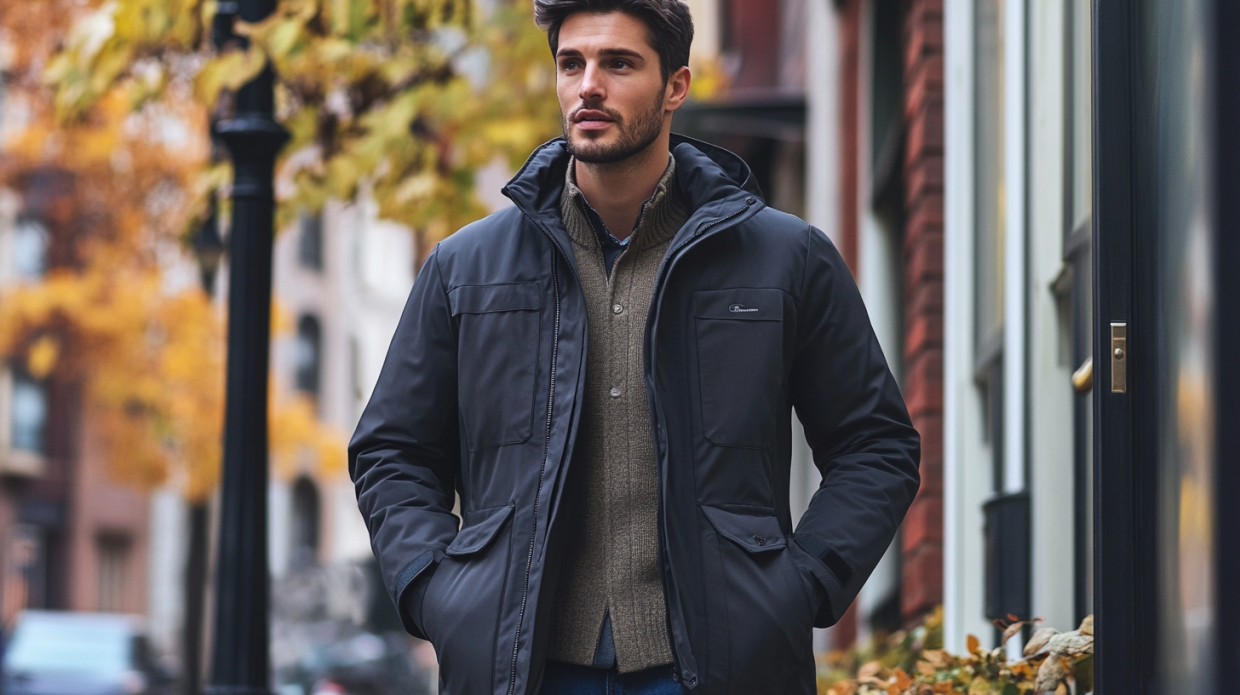
Kirkland Signature Diapers, Size 3, 222 ct
- Kirkland Signature Diapers
- Size 3
- 222 ct
Navigating the World of Budget-Friendly Quality for Your Growing Baby
When my sister called me at 2 AM, frantically explaining that she had run out of diapers and her 8-month-old was screaming, I knew exactly what to recommend. “Get to Costco first thing tomorrow and grab the Kirkland Size 3s,” I told her. Three days later, she called me back—this time at a reasonable hour—to thank me profusely for what she called “the best parenting hack” she’d discovered since having her little one.
If you’re in the throes of parenting a growing baby who’s recently outgrown their smaller diapers, you’re likely weighing your options carefully. Kirkland Signature diapers offer exceptional value without compromising on quality, making them a standout choice for budget-conscious parents who refuse to sacrifice performance.
Let’s dive deep into everything you need to know about Kirkland Diapers Size 3—from cost considerations to performance factors—to help you make an informed decision for your little one.
The Economics of Diapering: Breaking Down the Cost
As any parent knows, the diaper budget can quickly spiral out of control. When my neighbor Tom calculated how much he’d spent on diapers for his twins in their first year alone, he nearly fainted—over $2,000! This is precisely why cost-effectiveness matters tremendously.
Kirkland Diapers Size 3 currently cost around $42.99 per box at Costco (though prices may vary slightly by location). Each box contains a generous 198 diapers, which breaks down to approximately 22 cents per diaper. Compare this to premium brands like Pampers or Huggies, which often cost between 30-40 cents per diaper, and you’re looking at significant savings over time.
Let’s put this into perspective: If your baby goes through an average of 6-8 diapers daily (a conservative estimate for many), you’d use approximately 180-240 diapers per month. With Kirkland, that’s roughly $39.60-$52.80 monthly, whereas premium brands might set you back $54-$96 for the same period. The annual savings can easily exceed $300—enough for a nice crib upgrade or several months’ worth of baby food!
But the question remains: does the lower price point mean lower quality? This is where things get interesting.
Size and Fit: Finding the Perfect Match for Your Growing Baby
Size 3 Kirkland diapers are designed for babies weighing between 16-28 pounds, typically falling into the 5-8 month age range, though every baby develops differently. My friend’s daughter remained in Size 3 from 6 months until nearly her first birthday, while my nephew blazed through them in just two months before needing Size 4.
The thoughtfully designed elastic waistbands on Kirkland Size 3 diapers provide a secure yet comfortable fit that accommodates your baby’s movements. The leg cuffs create a gentle seal that prevents leakage without leaving those dreaded red marks that indicate too-tight elastic.
Many parents report that Kirkland Size 3 diapers offer an excellent middle-ground fit—not too snug like some premium brands and not too loose like certain economy options. This balance is particularly important as babies become more active, rolling, crawling, and even attempting those first wobbly stands.
One mother from my parenting group, Jessica, shared: “My daughter is extremely active, constantly climbing and crawling at lightning speed. The Kirkland Size 3s stay put through all her acrobatics, which is something I couldn’t say for the more expensive brand we used previously.”
What’s Inside Matters: Materials and Construction
When it comes to what touches your baby’s sensitive skin 24/7, materials matter tremendously. Kirkland Signature diapers are made from a blend of polypropylene, polyethylene, and absorbent wood pulp core. The inner lining features a soft, hypoallergenic material designed to minimize irritation.
Parents will be pleased to know that Kirkland Diapers Size 3 are:
- Free from chlorine bleaching
- Fragrance-free
- Latex-free
- Hypoallergenic
These features make them particularly suitable for babies with sensitive skin or those prone to diaper rash. The absence of fragrances eliminates unnecessary chemicals that can irritate delicate skin, while the chlorine-free processing reduces environmental impact and potential skin irritants.
While Kirkland diapers aren’t marketed as fully biodegradable or eco-friendly (an honest limitation to acknowledge), their manufacturing process does incorporate some environmentally conscious practices, including reduced packaging compared to some competitors.
Performance Where It Counts: Absorbency and Leak Protection
Let’s talk about what really matters in the middle of the night: does it keep the mess contained? Based on extensive personal experience and countless conversations with other parents, Kirkland Size 3 diapers excel in this department.
The absorbent core utilizes Super Absorbent Polymer (SAP) technology that quickly wicks moisture away from your baby’s skin, helping to prevent irritation and discomfort. This technology allows the diapers to hold a surprising amount of liquid for their size and price point.
For overnight use, most parents report satisfactory performance, though some with heavy wetters might need to size up or switch to a dedicated overnight diaper. My cousin’s son, a legendary heavy wetter, did well with Kirkland Size 3 when they used the “size up for nighttime” trick—using Size 4 for overnight while still using Size 3 during daytime hours.
One minor drawback is that Kirkland Size 3 diapers don’t feature a wetness indicator—those clever little lines that change color when the diaper is wet. For new parents still learning their baby’s cues, this might be an inconvenience, but most experienced parents find they quickly develop a sixth sense for when changes are needed anyway.
The Comparison Game: How Do They Stack Up Against Premium Brands?
The eternal question: are Kirkland diapers really comparable to the big-name brands? Having conducted an unofficial “diaper Olympics” with my mom friends (yes, we lead very exciting lives), I can share some insights.
When compared to Pampers Cruisers Size 3:
- Kirkland offers similar absorbency at approximately 40% less cost
- Pampers provides a slightly softer feel and includes a wetness indicator
- Both perform similarly for leak protection during active play
- Kirkland runs slightly larger, which some babies may need
Against Huggies Little Movers Size 3:
- Kirkland and Huggies demonstrate comparable leak protection
- Huggies offers slightly better fit for very active babies
- Kirkland provides better value, with more diapers per dollar
- Both offer similar levels of comfort and skin protection
What’s particularly interesting is that many parents suspect Kirkland diapers are actually manufactured by Huggies, given their similar construction and performance. While Costco doesn’t officially confirm their manufacturing partner, the similarities are notable.
Sarah, a mother of three from my neighborhood, switched from Huggies to Kirkland when her second child was born. “I honestly couldn’t tell the difference in performance,” she told me, “but I certainly noticed the difference in my bank account.”
Availability and Convenience Factors
One obvious limitation of Kirkland diapers is their availability—you’ll need a Costco membership (currently $60 annually) to purchase them in-store. However, this membership cost is typically offset by savings after just a few boxes of diapers, not to mention the savings on other baby essentials.
For those unable to make regular Costco runs, Kirkland Size 3 diapers can be purchased online through Costco’s website, though shipping costs may apply for non-members. Occasionally, they also appear on other online marketplaces, albeit usually at a markup.
Costco’s legendary return policy extends to their diapers as well. If you find they don’t work for your baby, you can return them for a full refund, even after opening the package and trying a few. This risk-free trial makes experimenting with Kirkland diapers a no-brainer for many parents.
A typical box of 198 Size 3 diapers lasts approximately one month for most babies, though this varies widely depending on your child’s age, size, and digestive habits. Some parents find it convenient to buy two boxes at once to minimize Costco trips, as the diapers’ packaging is designed for relatively compact storage.
Real Parents, Real Experiences: What the Reviews Say
While professional reviews are helpful, nothing beats the collective wisdom of thousands of parents in the trenches. Kirkland Size 3 diapers consistently receive 4.5-5 star ratings on Costco’s website, with most parents highlighting the excellent value-to-performance ratio.
Common praise points include:
- Exceptional absorption for the price point
- Minimal leaks, even with active babies
- Gentle on sensitive skin with few reports of diaper rash
- Consistent quality across boxes
- Sturdy tabs that withstand multiple adjustments
The most frequent criticisms center around:
- Lack of wetness indicator
- Slightly bulkier feel compared to premium ultra-thin options
- Occasional size inconsistencies between production batches
Maria, a first-time mom I met at a playgroup, summed it up well: “I was skeptical about ‘store brand’ diapers at first, but after a friend insisted I try Kirkland, I was shocked at how well they performed. We’ve been using Size 3 for three months now with zero blowouts, which feels like some kind of parenting miracle.”
Beyond the Basics: Special Considerations
For parents of particularly active babies—those early crawlers, climbers, and jumpers who never seem to stop moving—Kirkland Size 3 diapers generally keep pace well. The elastic leg cuffs and stretchy waistband accommodate movement while maintaining a secure seal against leaks.
Nighttime performance is adequate for most babies, though as mentioned earlier, extremely heavy wetters might benefit from sizing up or using a specialized overnight diaper. The absorbent core does a respectable job of pulling moisture away from the skin, helping babies stay comfortable through the night.
For babies with eczema or extremely sensitive skin, the hypoallergenic nature of Kirkland diapers makes them a good option, though not necessarily better than other fragrance-free, chlorine-free options on the market. Parents report minimal skin reactions, even with babies prone to rashes.
The Manufacturing Question: Where Do They Come From?
While Costco doesn’t widely publicize their manufacturing details, industry insiders suggest that Kirkland Signature diapers are produced in the United States, likely by one of the major diaper manufacturers who also produce their own branded products.
The quality control standards appear to be identical to those of premium brands, with consistent performance across packages and production runs. This reliability is crucial for parents who need dependable protection without surprises.
The similarity to Huggies’ construction has led many to speculate that Kimberly-Clark (Huggies’ parent company) manufactures Kirkland diapers, which would explain their comparable performance at a lower price point—a classic store-brand dynamic where the same manufacturer produces both premium and more affordable options.
Making the Transition: When to Move to Size 3 and Beyond
Knowing when to transition to Size 3 diapers can be tricky. The weight range (16-28 pounds) provides a guideline, but other signs that it’s time to size up from Size 2 include:
- Frequent leaks or blowouts
- Red marks around your baby’s waist or thighs
- Difficulty fastening the tabs comfortably
- The diaper no longer covers your baby’s bottom completely
Similarly, signs that your baby might be ready to move from Size 3 to Size 4 include:
- The diaper appears uncomfortably snug
- You notice leaking despite proper application
- The tabs barely reach or need to be fastened too tightly
- Your baby has reached or exceeded 28 pounds
Most babies remain in Size 3 for about 3-4 months, though this varies dramatically based on individual growth patterns. Some babies with slower growth might stay in Size 3 for 6+ months, while rapid growers might transition through in just 6-8 weeks.
The Bottom Line: Are Kirkland Size 3 Diapers Worth It?
After weighing all factors—cost, performance, materials, and real-world testing—Kirkland Signature Size 3 diapers represent one of the best values in the diaper market today. They offer premium-adjacent performance at a significantly lower cost per diaper, making them an excellent choice for budget-conscious families unwilling to compromise on quality.
For families already holding Costco memberships, trying Kirkland diapers is virtually risk-free thanks to the generous return policy. For those without memberships, the savings on diapers alone might justify the annual fee, especially for households with multiple children in diapers.
While they lack certain premium features like wetness indicators and aren’t marketed as eco-friendly, these limitations are reasonably balanced by their significant cost advantages and solid overall performance.
As one dad in my parenting group eloquently put it: “Kirkland diapers let me save for my kid’s college fund instead of literally throwing money in the trash—all without sacrificing performance or my baby’s comfort.”
Final Thoughts: Finding Your Diaper Sweet Spot
Parenting involves countless decisions, and choosing the right diaper might seem minor in the grand scheme. However, considering that your baby will likely wear around 6,000 diapers before potty training, this small decision can have significant financial and practical implications over time.
Kirkland Size 3 diapers occupy a sweet spot in the market—the intersection of affordability and performance that many parents find ideal. They prove that store brands can deliver excellent quality, challenging the assumption that higher prices necessarily mean better products.
Whether you’re a first-time parent navigating the overwhelming world of baby products or a veteran looking to optimize your budget without sacrificing quality, Kirkland Size 3 diapers deserve serious consideration. Your baby’s bottom—and your wallet—will likely thank you.
Remember that what works beautifully for one baby might not work for another, so remain flexible and observant as you find your family’s perfect diapering solution. After all, parenting is nothing if not a continuous process of discovery and adaptation—diaper choices included.




